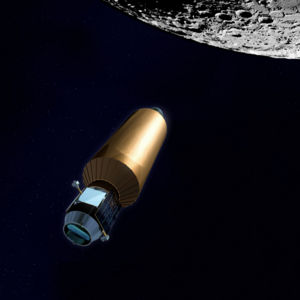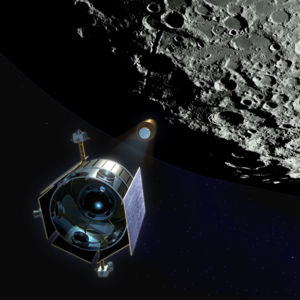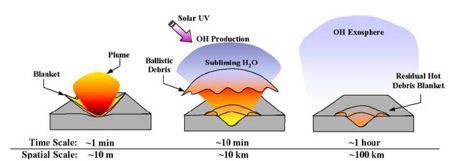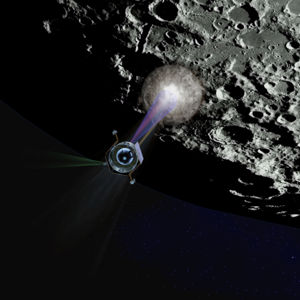Difference between revisions of "LCROSS"
m (stub sorting) |
(update) |
||
| (28 intermediate revisions by 2 users not shown) | |||
| Line 1: | Line 1: | ||
| − | [[LCROSS]] Lunar Crater Observation and Sensing Satellite | + | [[Image:LCROSSmain_lunarorbiter3.jpg|right|thumb|300px|LCROSS ready to separate from its Centaur upper stage. Photo credit: NASA]] |
| + | |||
| + | {|align=left | ||
| + | |__TOC__ | ||
| + | |} | ||
| + | |||
| + | LCROSS Lunar Crater Observation and Sensing Satellite | ||
| + | |||
| + | The Lunar CRater Observation and Sensing Satellite (LCROSS), was purpose built to search for [[water|H<sub>2</sub>O]] on the [[Moon]] and was launched as a secondary payload on [[Lunar Reconnaissance Orbiter]]. The smaller secondary payload spacecraft traveled with the Lunar Reconnaissance Orbiter (LRO) satellite to the moon on the same Atlas-Centaur EELV rocket launched from Cape Canaveral Air Force Station, Florida, on June 18, 2009. After launch, the 'secondary payload,' LCROSS spacecraft arrived in the lunar vicinity independent of the LRO satellite. On the way to the moon, the spacecraft's two main parts, the Shepherding Spacecraft (S-S/C) and the [[Centaur]] Upper Stage remained coupled. | ||
| + | |||
| + | |||
| + | |||
| + | [[Image:LCROSSmain_lunarorbiter2.jpg|left|thumb|300px|LCROSS Centaur upper stage heading towards impact site. Photo credit: NASA]] | ||
| + | |||
| + | As the spacecraft approached the moon's south pole, the 2000kg Centaur separated and then impacted a crater in a polar region of the moon 7 hours later at 9,000 km/hr, producing an explosion 200 times more powerful than that of [[Lunar Prospector]] and equivalent to about 2,000 pounds of TNT (6.5 billion joules). The blast jettisoned a plume of material out of the crater where astronomers searched the debris for signs of lunar water. The plume from the Centaur crash developed as the Shepherding Spacecraft headed in towards the moon. The S-S/C flew through the plume, and instruments on the spacecraft analyzed the cloud to look for signs of water and other compounds. Additional space and earth-based instruments also studied the huge plume, which scientists expected to be 1000 metric tons. The booster impact occured on October 9, 2009, at 11:31 UTC. The other half of the LCROSS mission, weighing 700kg (the Shepherding Spacecraft), observed the impact and then itself crashed into the Moon 4 minutes later. Researchers estimated that the regolith at the impact site contained 5.6 ± 2.9% water ice..<ref>[http://www.psrd.hawaii.edu/Archive/Archive-Moon.html PSRD ''CosmoSparks Report''--''An Icy Treat'']</ref> | ||
| + | |||
| + | |||
| + | |||
| + | Most of the Moon lacks water and is extremely low in other volatiles. With a very tenuous argon astmosphere and 300° temperature swings between night and day, most of the Moon's surface is a hostile place for water. However there are a few cold, dark places where water molecules could collect and remain frozen. At the lunar poles, the sun is always low on the horizon, so some crater ridges cast shadows that keep parts of the crater floors in perpetual darkness. Temperatures in the shadows hover around 40° above absolute zero (-233° Celsius), cold enough for water ice to survive indefinitely. | ||
| + | |||
| + | NASA Science News described what the event would look like in this way: "The explosion itself will probably be hidden by the walls of the target crater. Instead, what astronomers will look for is the impact plume. An expanding cone of ejecta will rise more than 6 kilometers above the lunar surface and spread outward for about 40 km in every direction. Glistening in the sunlight the debris is expected to shine like a 6th to 8th magnitude star—invisible to the human eye but an easy target for backyard telescopes."<ref name="update08"/> | ||
| + | |||
| + | [[Image:LunarImpact.jpg|right|thumb|450px|The life cycle of a lunar impact and associated time and special scales. The LCROSS measurement methods are “layered” in response to the rapidly evolving impact environment. Photo Credit: NASA]] | ||
| + | |||
| + | The LCROSS mission showed there is water hidden in some permanently dark craters on the moon. Anthony Colaprete said: "If LCROSS's booster stage hits a patch of lunar regolith that contains at least 0.5 percent water ice, water should be detectable in the plume of ejecta,"<ref name="update08">[http://science.nasa.gov/headlines/y2008/11aug_lcross.htm?list994099 A Flash of Insight: LCROSS Mission Update] - Edited by Dr. Tony Phillips, [http://science.nasa.gov/ Science@NASA]</ref> and so it ocurred. | ||
| − | + | ==Science Payload== | |
| + | The LCROSS science payload consisted of two near-infrared spectrometers, a visible light spectrometer, two mid-infrared cameras, two near-infrared cameras, a visible camera and a visible radiometer. | ||
| + | {| | ||
| + | | STYLE="background:#d1d1d1" COLSPAN="2" ALIGN="center"|'''LCROSS Science Loadout''' | ||
| + | |- | ||
| + | | STYLE="background:#d1d1d1" |'''Instrument''' | ||
| + | | STYLE="background:#d1d1d1" |'''Target''' | ||
| + | |- | ||
| + | | STYLE="background:#d1d1d1" |Near Infra-red Spectrometers(2) | ||
| + | | STYLE="background:#d1d1d1" |Ice, Vapor, Grain Size, Hydrates | ||
| + | |- | ||
| + | | STYLE="background:#d1d1d1" |Visible Spectrometer | ||
| + | | STYLE="background:#d1d1d1" |H2O+ (619 nm), OH (308nm), Search organics | ||
| + | |- | ||
| + | | STYLE="background:#d1d1d1" |Mid Infra-red Cameras(2) | ||
| + | | STYLE="background:#d1d1d1" |Pre-impact terrain, Total Water, Ejecta Blanket | ||
| + | |- | ||
| + | | STYLE="background:#d1d1d1" |Near Infra-red Cameras(2) | ||
| + | | STYLE="background:#d1d1d1" |Total Water | ||
| + | |- | ||
| + | | STYLE="background:#d1d1d1" |Visible Context Camera | ||
| + | | STYLE="background:#d1d1d1" |Impact location, Plume morphology | ||
| + | |- | ||
| + | | STYLE="background:#d1d1d1" |Visible Photometer | ||
| + | | STYLE="background:#d1d1d1" |Flash light curve | ||
| + | |- | ||
| + | | COLSPAN="2" ALIGN="center" | LCROSS Technical Info: Instruments<ref>[http://lcross.arc.nasa.gov/instruments.htm LCROSS Technical Info: Instruments]</ref> | ||
| + | |- | ||
| + | |} | ||
| − | |||
| − | + | [[Image:LCROSSmain_lunarorbiter1.jpg|left|thumb|300px|LCROSS plume developing with S-SC looking outward and down. Photo credit: NASA]] | |
| − | Principal Investigator: [[Dr. Anthony Colaprete]] | + | ==Project Team<ref name="lcross">[http://lcross.arc.nasa.gov/bios.htm LCROSS - Biographies of the LCROSS Mission Team]</ref><ref name="ssad">[http://spacescience.arc.nasa.gov/LCROSS/ The LCROSS Mission - Space Science and Astrobiology Division - NASA AMES]</ref>== |
| + | *Sponsor: [[NASA Ames Research Center]] | ||
| + | *Principal Investigator: [[Dr. Anthony Colaprete]] | ||
| + | *Project Manager: [[Daniel Andrews]] | ||
| + | *Co-investigator: [[Dr. Jennifer Heldmann]] | ||
| + | *Deputy Project Manager: [[John Marmie]] | ||
| + | *Payload Scientist: [[Dr. Kimberly Ennico]] | ||
| + | *Mission Operations System Team Lead & Flight Director: [[Paul Tompkins]] | ||
| + | *Space and Aircraft Mission Analysis: [[Roger Arno]] | ||
| + | *Project Systems Engineer: [[Darin Foreman]] | ||
| + | *System Safety & Mission Assurance Manager: [[Leonard Hee]] | ||
| + | *[[Diane Wooden]] | ||
| + | *[[Tony Ricco]] | ||
| + | *[[Geoff Briggs]] | ||
| + | *[[LPRP]] Program Scientist: [[Ben Bussey]] | ||
| + | *Prime Contractor: [[Northrup Space Technologies]] of Redondo Beach, Calif. | ||
| − | [http://spacescience.arc.nasa.gov/LCROSS/ LCROSS | + | ==External Links== |
| + | *[http://spacescience.arc.nasa.gov/LCROSS/ The LCROSS Mission - Space Science and Astrobiology Division - NASA AMES] | ||
| + | *[http://lcross.arc.nasa.gov/index.htm LCROSS - National Aeronautics and Space Administration] | ||
| − | + | ==References== | |
| + | <references/> | ||
[[Category:Landers]] | [[Category:Landers]] | ||
Latest revision as of 12:14, 18 April 2013
LCROSS Lunar Crater Observation and Sensing Satellite
The Lunar CRater Observation and Sensing Satellite (LCROSS), was purpose built to search for H2O on the Moon and was launched as a secondary payload on Lunar Reconnaissance Orbiter. The smaller secondary payload spacecraft traveled with the Lunar Reconnaissance Orbiter (LRO) satellite to the moon on the same Atlas-Centaur EELV rocket launched from Cape Canaveral Air Force Station, Florida, on June 18, 2009. After launch, the 'secondary payload,' LCROSS spacecraft arrived in the lunar vicinity independent of the LRO satellite. On the way to the moon, the spacecraft's two main parts, the Shepherding Spacecraft (S-S/C) and the Centaur Upper Stage remained coupled.
As the spacecraft approached the moon's south pole, the 2000kg Centaur separated and then impacted a crater in a polar region of the moon 7 hours later at 9,000 km/hr, producing an explosion 200 times more powerful than that of Lunar Prospector and equivalent to about 2,000 pounds of TNT (6.5 billion joules). The blast jettisoned a plume of material out of the crater where astronomers searched the debris for signs of lunar water. The plume from the Centaur crash developed as the Shepherding Spacecraft headed in towards the moon. The S-S/C flew through the plume, and instruments on the spacecraft analyzed the cloud to look for signs of water and other compounds. Additional space and earth-based instruments also studied the huge plume, which scientists expected to be 1000 metric tons. The booster impact occured on October 9, 2009, at 11:31 UTC. The other half of the LCROSS mission, weighing 700kg (the Shepherding Spacecraft), observed the impact and then itself crashed into the Moon 4 minutes later. Researchers estimated that the regolith at the impact site contained 5.6 ± 2.9% water ice..[1]
Most of the Moon lacks water and is extremely low in other volatiles. With a very tenuous argon astmosphere and 300° temperature swings between night and day, most of the Moon's surface is a hostile place for water. However there are a few cold, dark places where water molecules could collect and remain frozen. At the lunar poles, the sun is always low on the horizon, so some crater ridges cast shadows that keep parts of the crater floors in perpetual darkness. Temperatures in the shadows hover around 40° above absolute zero (-233° Celsius), cold enough for water ice to survive indefinitely.
NASA Science News described what the event would look like in this way: "The explosion itself will probably be hidden by the walls of the target crater. Instead, what astronomers will look for is the impact plume. An expanding cone of ejecta will rise more than 6 kilometers above the lunar surface and spread outward for about 40 km in every direction. Glistening in the sunlight the debris is expected to shine like a 6th to 8th magnitude star—invisible to the human eye but an easy target for backyard telescopes."[2]
The LCROSS mission showed there is water hidden in some permanently dark craters on the moon. Anthony Colaprete said: "If LCROSS's booster stage hits a patch of lunar regolith that contains at least 0.5 percent water ice, water should be detectable in the plume of ejecta,"[2] and so it ocurred.
Science Payload
The LCROSS science payload consisted of two near-infrared spectrometers, a visible light spectrometer, two mid-infrared cameras, two near-infrared cameras, a visible camera and a visible radiometer.
| LCROSS Science Loadout | |
| Instrument | Target |
| Near Infra-red Spectrometers(2) | Ice, Vapor, Grain Size, Hydrates |
| Visible Spectrometer | H2O+ (619 nm), OH (308nm), Search organics |
| Mid Infra-red Cameras(2) | Pre-impact terrain, Total Water, Ejecta Blanket |
| Near Infra-red Cameras(2) | Total Water |
| Visible Context Camera | Impact location, Plume morphology |
| Visible Photometer | Flash light curve |
| LCROSS Technical Info: Instruments[3] | |
Project Team[4][5]
- Sponsor: NASA Ames Research Center
- Principal Investigator: Dr. Anthony Colaprete
- Project Manager: Daniel Andrews
- Co-investigator: Dr. Jennifer Heldmann
- Deputy Project Manager: John Marmie
- Payload Scientist: Dr. Kimberly Ennico
- Mission Operations System Team Lead & Flight Director: Paul Tompkins
- Space and Aircraft Mission Analysis: Roger Arno
- Project Systems Engineer: Darin Foreman
- System Safety & Mission Assurance Manager: Leonard Hee
- Diane Wooden
- Tony Ricco
- Geoff Briggs
- LPRP Program Scientist: Ben Bussey
- Prime Contractor: Northrup Space Technologies of Redondo Beach, Calif.
External Links
- The LCROSS Mission - Space Science and Astrobiology Division - NASA AMES
- LCROSS - National Aeronautics and Space Administration










